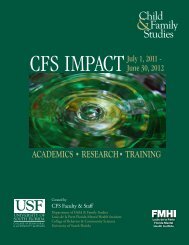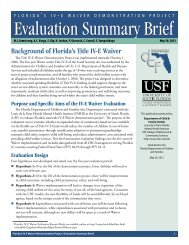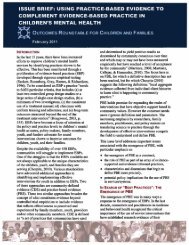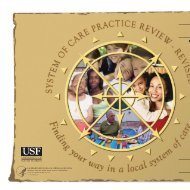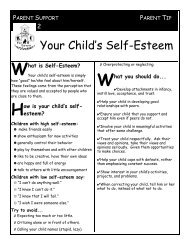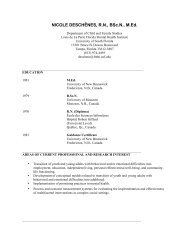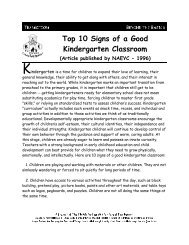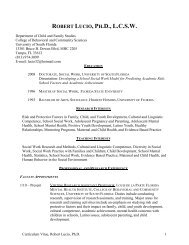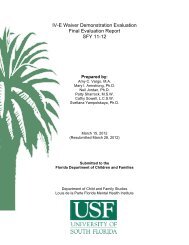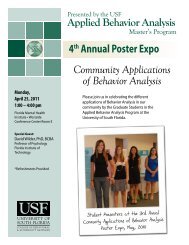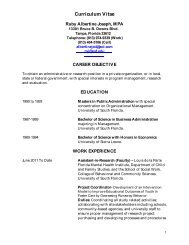The Early Learning Opportunities (ELO) Act - Child & Family Studies
The Early Learning Opportunities (ELO) Act - Child & Family Studies
The Early Learning Opportunities (ELO) Act - Child & Family Studies
You also want an ePaper? Increase the reach of your titles
YUMPU automatically turns print PDFs into web optimized ePapers that Google loves.
Evaluation of the <strong>Early</strong> <strong>Learning</strong> <strong>Opportunities</strong> <strong>Act</strong><br />
students. <strong>The</strong> questions were all neutral and open-ended. <strong>The</strong> questions are listed in Table 7.<br />
<strong>The</strong> focus groups were recorded and transcribed for precision of quotes and themes. During<br />
the focus groups, a volunteer from the group recorded the comments summarized by the<br />
facilitator. Once the groups were transcribed, a team of evaluators reviewed the notes for<br />
themes.<br />
Follow-Up Coaching Survey. An informal survey was provided to all participants following<br />
their last coaching session. <strong>The</strong> participants mailed the completed survey to the supervisor of<br />
the coaches. <strong>The</strong> survey was developed by the coaches and asked the participants to respond<br />
to questions about their experience with the HUR! Course and coaching. Responses related to<br />
coaching will be used in the evaluation report.<br />
<strong>Child</strong>ren<br />
Screening for <strong>Early</strong> Literacy <strong>Learning</strong>. A review of measures to assess children’s early<br />
literacy development reveals a significant void particularly when attention is directed to teacher<br />
ratings of student’s skill development. Consequently, the Program Evaluation Team developed<br />
a screening instrument that would gather information on emerging literacy skills in children<br />
between the ages of six months to five years of age. This measure, the Screening for <strong>Early</strong><br />
Literacy <strong>Learning</strong> (SELL), is a teacher rating scale that taps four key domains of literacy<br />
development: Communication Skills, Reading, Recognizing Letters, and Responses to Letter<br />
Sounds. Items comprising the SELL were generated from a review of research on<br />
developmental milestones, language, and literacy skill acquisition (e.g., Berk, 2003; Bredekamp<br />
& Copple, 1997; Clay, 1991; McCathren, Warren, & Yoder, 1996; Snow, Burns, & Griffin, 1998).<br />
<strong>The</strong> end product contained ten observable behaviors presented along a continuum reflecting the<br />
typical progression of skills for each area ranging from the lowest (e.g., never looks at books) to<br />
the highest-level skills of development (e.g., child reads isolated words) (see Appendix B).<br />
Completion of the SELL involves the teacher circling the item and corresponding number that<br />
best describes a targeted child.<br />
Subscale scores and total scores are obtained. Specifically, scores for each domain<br />
reflected the highest skill or number circled by the teacher. Total scores were obtained by<br />
summing each of the four domain scores. Psychometric properties of the SELL indicate that it<br />
holds promise as a reliable measure of skill acquisition for children between the ages of six<br />
months to one year. That is, internal consistency was moderate with an r = .65 (Cronbach’s<br />
Alpha) obtained. Further exploration also documented strong concurrent validity when the<br />
relationship between scores obtained on the Communication Skills domain and the<br />
Communication subscale on the Ages and Stages Questionnaire were examined (Pearson<br />
Product Moment Correlation = .65).<br />
Individual Growth and Development Indicators. <strong>The</strong> preschool form of the Individual Growth<br />
and Development Indicators (IGDI) was developed by McConnell and McEvoy at the University<br />
of Minnesota. <strong>The</strong>ir efforts were driven by the goal of developing a General Outcome Measure<br />
(GOM) that assessed early literacy skills such as expressive language and phonemic<br />
awareness in children between the ages of three to five years (McConnell, Priest, Davis, &<br />
McEvoy, 2002; Priest et al, 2001). Psychometrics properties of these instruments describe the<br />
IGDI as a valid and reliable index of children’s literacy growth and development (Priest, Davis,<br />
Louis de la Parte Florida Mental Health Institute, University of South Florida – page 10



